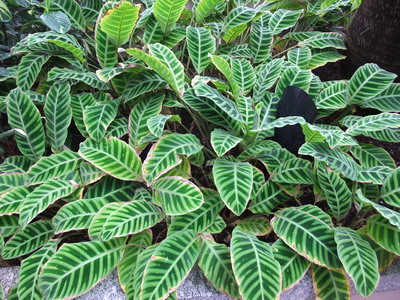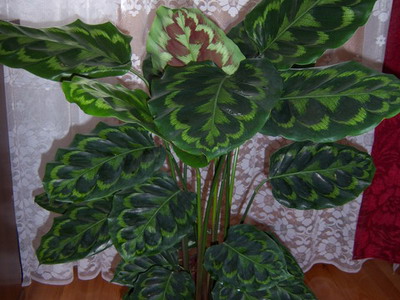The genus Calathea belongs to the family Maranthaceae. In nature, the Calathea plant grows in the tropics of South America. The genus name comes from the ancient Greek mlathos (“basket”): the leaves and stems of these flowers were used to weave baskets.
The leaves of the plant are unusually beautiful: large (up to 30 cm in length), oval or elliptical, sometimes elongated, growing from the rosette. They always turn towards the sun. All have one feature – in the evening their leaves rise up, and in the morning they fall down again. For this feature, calathea is often called the “prayer flower.”
Description of Calathea species and their photos
There are many types of indoor calathea, you can see their photos in our photo gallery, as well as read the recommendations for caring for and propagating the plant at home.
Wonderful calathea (Calathea insignis) is distinguished by very long (up to 50 cm) light green leaves, directed vertically upwards and decorated with a magnificent pattern of alternating large and small spots. The underside of the leaf is purple.

Calathea Macoyana is a perennial rhizomatous herbaceous plant. Large oval silver-green leaves are located on long (up to 14 cm) petioles, have dark green oblong spots of various sizes along the middle and lateral veins. Below the leaves are purple with the same pattern.

Calathea striped (Calathea zebrina) is a powerful plant up to 80 cm high. Oblong velvety leaves are located on long petioles and are collected in basal rosettes. They are bright green with dark brownish-green broad stripes along the lateral veins, purple underneath, especially when young. The flowers are purple.

Known variety var. humilior – the description of this calathea is similar to the description of the zebrina form, however, the “humilior” has smaller, green leaves below.

Calathea decorated (Calathea ornata) is a rhizomatous herbaceous plant 50-60 cm high. Oblong leaves up to 30 cm long and 9-11 cm wide are collected in basal rosettes.

In culture, a variety of roseolineate (var. roseolineata) is usually grown with dark green shiny leaves, first decorated with bright pink, later with silvery-white lines arranged in pairs along the lateral veins; Leaves are dark purple underneath.

A variety of sanderian (var. sanderiana) is also popular.

Calathea leopard (Calathea leopardina) – a plant 40-50 cm high. The leaves are lanceolate, 10-15 cm long and 3-5 cm wide, with the right combination of dark spots of different sizes.

Calathea Rufibarba (Calathea rufibarba) has oblong leaves slightly wavy along the edges. They are painted in various shades from light green to dark green, without a pattern. The name of this type of calathea in translation means “red-bearded”, due to the fact that the lower part of the leaves and petioles are covered with light fluff.

Calathea Lubbers (Calathea lubbersii) – a plant 70-80 cm high. The leaves are large, up to 30 cm in length, oval, on long petioles. The pattern on the leaves – large bright green and yellow spots – is asymmetrical. The underside of the leaf blade is green, not purple like most species.

Calathea warscewiczii (Calathea warscewiczii) has large dark green velvety leaves with a light green pattern along the central vein. The underside of the leaves is dark purple. Before flowering, it forms long cranked shoots that require support, so the plant needs a lot of space. Cream colored bracts. Calathea flowers of this species are white, cream or pink.

Calathea Vicha, or Veitcha (Calathea veitchiana) , reaches a height of 90 cm. Its leaves are oval, 20-30 cm long and 10-15 cm wide, shortly pointed at the top, weakly heart-shaped at the base, strong, glossy. The color of the leaves is dark green, above with light yellow-green stripes, below with light yellowish stripes on a reddish background. The flowers are white, on a long stalk, collected in spike-shaped inflorescences.

Calathea saffron (Calathea crocata) is the only species that blooms in cultivation. Dark green leaves with a brownish tint are located on long petioles. Flowers are orange-red. The underside of the leaves is dark purple with a violet tinge. To stimulate flowering, from October to the end of December, plants are kept without artificial lighting.

Caring for room calathea at home
Calatheas are quite difficult to grow in culture. In the capable hands of experienced flower growers, they will grow simply in a pot, but it is much easier to grow them in a florarium.
Indoor calatheas develop well in diffused light. In winter, it is desirable to additionally illuminate the plants. They do not tolerate direct sunlight during the spring and summer months. The size and color of the leaves depend on how well the plant is protected from the sun. In very bright light, the leaves lose their color and shrink.
When caring for calathea at home, it is necessary to provide certain temperature conditions. Plants do not tolerate cold drafts and require a temperature of at least 18 ° C in winter. In the spring-summer period, the optimum temperature during the day should be 22-30 ° C, at night it can be a little cooler. A sudden change in temperature can be detrimental to the most tender varieties, causing the leaves to become lethargic and rot.
Calathea is very demanding on watering, especially in the summer. In addition, the plant needs high humidity. Water abundantly in summer. Well-settled or filtered water is regularly sprayed with a fine spray, since large drops of water should not fall on the leaves – dark spots may appear on them. Species with soft velvety leaves do not spray or wipe – for them they create a moist environment in the pan from moss, pebbles or expanded clay, filled with water. The bottom of the pot should not touch the water.
Reduce watering in winter. Dry air causes yellowing, drying and curling of the leaves, with an excess of moisture, the roots rot. If you do not adjust the watering regime, then the calathea can completely shed its leaves. Calathea Makoya is especially sensitive to waterlogging of the soil substrate.
During the period of active growth, plants are fed once every two weeks with a weak (0.5% or less of the norm) solution of mineral fertilizers with a low calcium content. For Calathea saffron, fertilizers for flowering plants are used.
Young calatheas are transplanted annually, adults – once every two years in late spring or summer. When transplanting, old dying leaves are removed. A pot for plants is chosen shallow. The soil should be nutritious, loose and permeable, slightly acidic (pH up to 6). The optimal soil mixture is prepared from leaf and humus soil, peat and sand (1: 1: 1: 0.5). Good drainage is required (up to 1/4 of the height of the pot).
Reproduction of Calathea
Calathea is propagated by dividing the bush. These plants form rhizomes and nodules, in the adult state the rhizomes branch and are easily separated during transplantation. Large calatheas are carefully divided into two or three new specimens, while trying not to damage the roots. Planted in a peat-based substrate, after which it is thoroughly watered with lukewarm water and the surface is allowed to dry before the next watering. The pots are placed in a loosely tied plastic bag and kept in a warm place until new leaves appear. When the plant is well rooted, it is transferred to a larger pot, 2 cm larger than the previous one. The optimum temperature for growing a healthy plant is 22-24°C.
Young calathea flowers are kept in a shady place, regularly sprayed and watered abundantly. With the onset of intensive growth, in the summer, feed every three weeks. The following year, the plant is transplanted into a larger pot and cared for as an adult plant.
Indoor calatheas infect spider mites, scale insects. If the optimal mode of keeping the plant is violated, a change in color, various necrosis and death of the leaves, as well as rotting of the roots, are possible.







